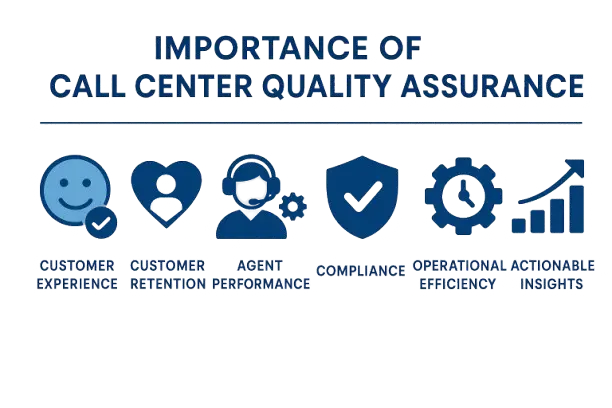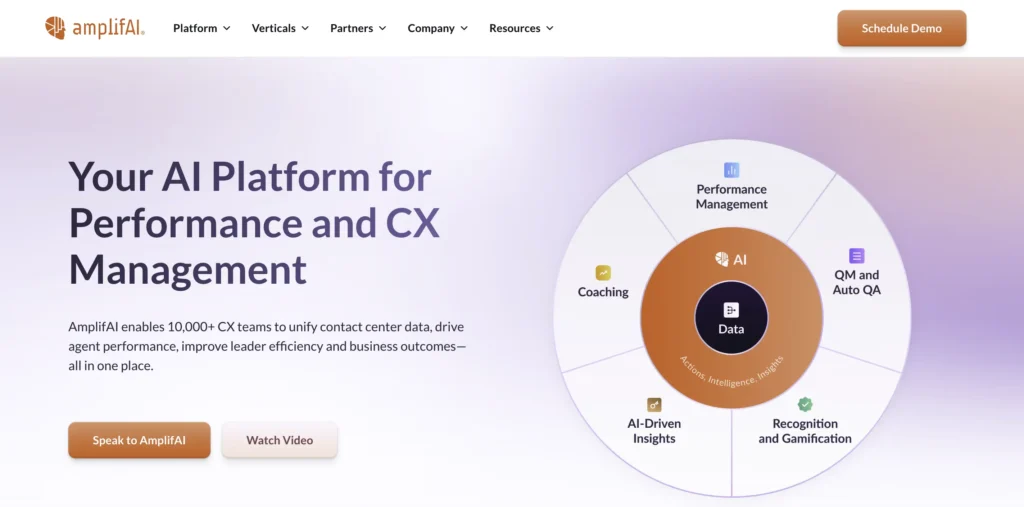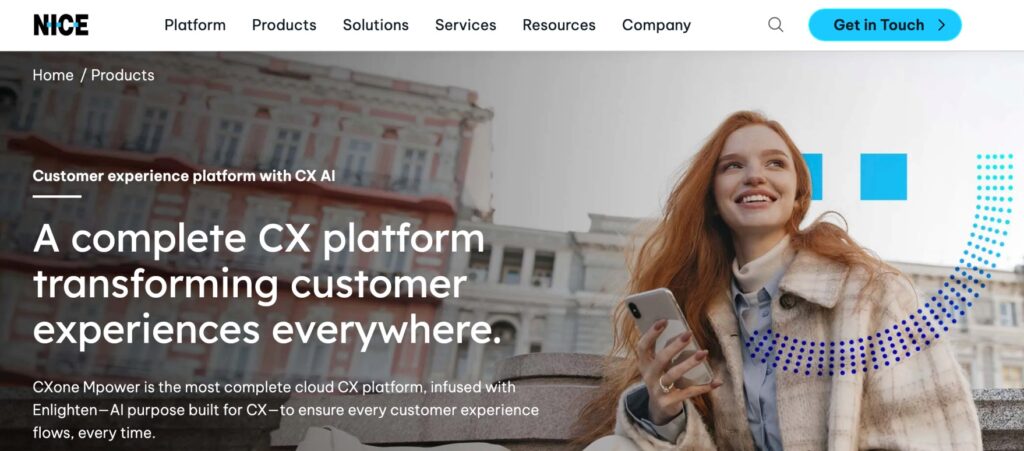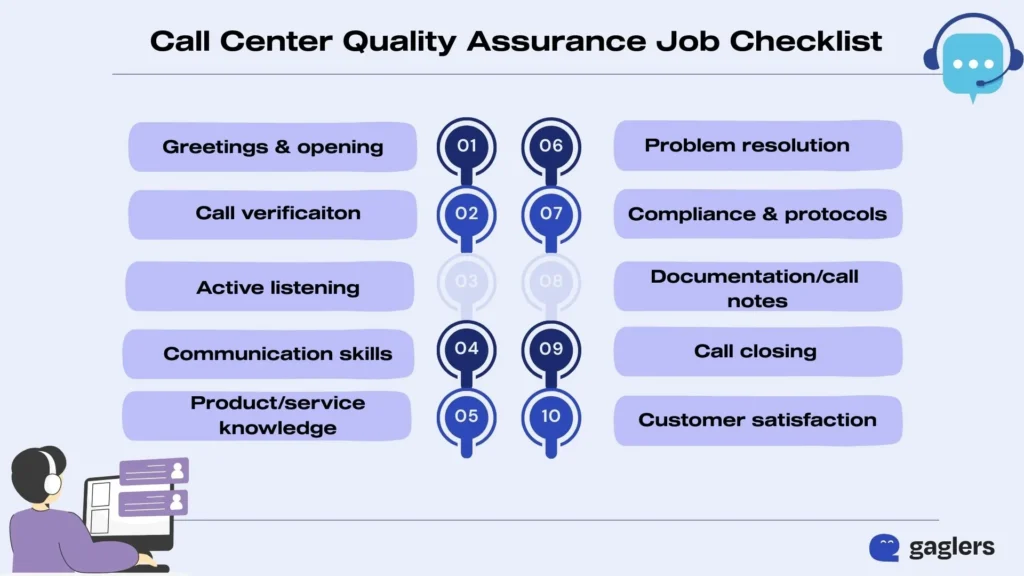Call center quality assurance stands at the heart of every successful customer interaction. 95% of call center professionals see customer satisfaction as the most critical call center metric.
With customer expectations now higher than ever, a single negative interaction will send them straight to your competitors.
If you are evaluating call center quality assurance solutions or are looking to improve your existing program, then this comprehensive guide will show you exactly how to build a quality assurance system for your organization.
Difference between call center quality assurance & quality control
Before we dive into anything else, let’s understand the difference between QA (quality assurance) and QC (quality control). These two concepts serve different purposes and have distinct impacts on performance, customer satisfaction, and operational efficiency.
Let me break it down for you:
| Aspect | Quality Assurance | Quality Control |
| Approach | Preventive (proactive) | Corrective (reactive) |
| Focus | Ensuring agent performance meets standards and client requirements. | Ensuring service quality by identifying causes, effects, and planning resolutions. |
| Main goal | Prevent problems by setting standards and monitoring processes. | Detect and correct issues in delivered service. |
| Activities | Call monitoring, scorecards, audits, training, and coaching. | Service inspection, error tracking, and customer feedback collection. |
| Responsiblity | QA managers, team leaders, and the operations head. | Service managers, project managers, and the management panel. |
| Scope | Strategic, ongoing improvement. | Tactical, focused on specific incidents/results. |
Why is call center quality assurance important?

Call center quality assurance directly impacts customer satisfaction, operational efficiency, and business growth. Here’s why QA deserves a central role in your contact center strategy:
| Advantages of QA | Description |
| Enhances customer experience and satisfaction. | Ensures every customer interaction meets brand standards, leading to higher CSAT (Customer Satisfaction Score) and NPS (Net Promoter Score), and reducing repeat contacts. |
| Drives customer retention & brand loyalty. | Consistent quality builds trust & loyalty, increasing repeat business and positive word-of-mouth. |
| Improves agent performance & experience. | Regular feedback and coaching empower agents, boost morale, and lead to better customer outcomes. |
| Promotes regulatory compliance & reduces risk. | Ensures agents follow scripts, policies, and regulations, protecting the company from fines and reputational harm. |
| Boost operational efficiency & reduce cost. | Identifies inefficiencies and lowers repeat contacts and escalations, reducing operational costs. |
| Provides actionable insights for improvement. | Delivers valuable customer needs and agent performance data, enabling informed decisions and continuous process refinement. |
Best practices in call center quality assurance
Given how call center quality assurance is integral to your business growth, a modern program must cater to all interactions, whether inbound or outbound calls or digital messages.
Here’s how you can build a modern QA program that meets today’s expectations:
Define a clear QA metric
Start by establishing what “quality” means for you and your organization and how it aligns with your business objectives and customer satisfaction. The most successful programs track both operational efficiency and customer experience quality.
Essential metrics to track:
- First Call Resolution (FCR) rate: Target 70 – 80%
- Customer satisfaction (CSAT) score: Target 70% +
- Net Promoter Score (NPS): Target 50 +
- Average Handle Time (AHT): Industry-specific benchmarks
- Quality score: Between 75% and 90%
- Agent utilization rate: Target 75%
| Tip: Use a balanced scoreboard approach that weights customer experience metrics at 60% and operational metrics at 40% to maintain focus on customer satisfaction while managing efficiency. |
Call recording and real-time monitoring
Monitor live and recorded interactions to assess agent performance, ensure compliance, and identify coaching opportunities. Real-time monitoring enables immediate feedback and intervention.
Modern call recording systems give you more than just a basic audio capture. Platforms like Gaglers provide your organizations with AI-powered insights, sentiment analysis, and automated quality scoring.
Tips for monitoring your calls:
- Monitor 10-15% of calls manually to get a detailed analysis.
- Use AI to screen 100% of calls for compliance and quality flags.
- Implement both live monitoring and post-call review processes.
- Ensure proper consent and privacy compliance.
Implement comprehensive training
Training helps transform the QA insights into performance improvements. The most effective programs use multiple training approaches to address different learning styles and skill gaps. For example:
- Persona-based training: Develop detailed customer personas based on demographics, communication preferences, and typical issues—train agents to recognize persona indicators and adapt accordingly.
- Customer empathy: Focus on emotional intelligence skills, including active listening, emotional recognition, and appropriate response strategies.
| Did you know? 70% of buying decisions come down to how customers feel they’re being treated. When you show empathy, you make customers feel valued, and that human connection often makes the biggest difference in resolving concerns and earning their loyalty. |
- Knowledge-based training: Ensure agents have immediate access to accurate, current information through:
- Regular product knowledge updates.
- Policy and procedure training.
- System navigation training.
- Scenario-based learning exercises.
Leverage AI and automation tools
Artificial intelligence-driven QA software like Gaglers can automate call scoring, deliver real-time feedback, and surface actionable insights. This reduces manual effort and ensures evaluations are objective and comprehensive. With built-in predictive analysis, Gaglers can anticipate customer needs and help reduce churn.
| Did you know? Gartner projects that automation in agent interactions will grow fivefold, rising from 1.8% in 2022 to around 10% by 2026. This will help reduce the labor cost of call center agents by $80 billion. |
Incorporate customer feedback.
Customer feedback is a goldmine for continuous improvement. It provides external validation of your internal quality measures and reveals gaps in your evaluation criteria.
According to studies, over 77% of customers have a more favourable view of brands that ask for and accept feedback.
Pointers on how to integrate the feedback:
- Correlate internal call center quality assurance scores with customer satisfaction ratings.
- Use post-call surveys to validate quality assessment.
- Analyze customer complaints for call center quality assurance program improvements.
- Create feedback loops between customer insights and training programs.
How does software help with call center quality assurance
Call center quality assurance software eliminates manual processes and provides deeper insights across operations. The right platform integrates effortlessly with existing systems while providing advanced analytics and automation capabilities.
Here are some key software features:
- Automated call monitoring & scoring: Analyze every interaction, not just a random sample of calls for quality management.
Learn how to from: The Latest call center monitoring tips you need in 2025.
- AI-Powered analytics: Uncover trends, root causes, and compliance risks with advanced analytics and sentiment detection.
- Real-time insights: Identify issues as they happen, not days later.
- Omnichannel Integration: Connect with CRMs and workforce management tools.
- Comprehensive reporting: Generate actionable insights for continuous improvement.
Top 5 call center quality assurance software solutions
Choosing the right call center quality assurance software is a game-changer for elevating call center performance. Here are some of the leading platforms for your business:
1. Gaglers

Among the leading QA software platforms, Gaglers enables businesses to automate, monitor, and elevate customer interactions.
Unlike platforms that rely on random sampling, Gaglers evaluates 100% of customer interactions using advanced AI, ensuring no feedback slips through the cracks.
Not only that, you can add and remove as many agents as you need with no extra charge, making it a cost-effective choice.
What sets Gaglers apart:
- Automated AI-driven evaluation of all customer interactions.
- Evaluates thousands of calls in no time to flag anomalies.
- Real-time dashboards and actionable performance analytics.
- Seamless CRM and omnichannel integration.
- Scalable, user-friendly platform for teams of any size.
If you want to maximize agent performance, ensure regulatory compliance, and deliver consistently exceptional CX without the hassle of manual QA, Gaglers is the solution for you.
2. AmplifAI

AmplifAI is a data-driven performance management platform designed to boost call center results through personalized, AI-powered coaching.
It analyzes every customer interaction to deliver targeted feedback and automated coaching workflows that help agents improve faster.
AmplifAI delivers:
- AI-driven analysis of all agent interactions.
- Personalized coaching recommendations and automated workflows.
- Gamification to increase agent engagement.
- Integration with CRM platforms.
- Organization-wide performance dashboards and reporting.
AmplifAI is a strong choice if you want to empower your agents with real-time, actionable insights and foster a culture of continuous improvement.
3. NICE CXone

NICE CXone is a comprehensive cloud call center suite that streamlines omnichannel customer service, workforce management, and quality assurance in one platform. Its advanced QA tools leverage AI to monitor, score, and analyze every interaction.
What they provide:
- Omnichannel interaction analytics and automated QA scoring.
- Speech analytics with sentiment detection.
- Workforce optimization and scheduling tools.
- Secure, cloud-based infrastructure for global teams.
- Integrations with CRMs and business applications.
4. Convin.ai

Convin.ai is an AI-powered quality monitoring platform that automates call audits, surfaces actionable insights, and streamlines compliance for modern contact centers.
It reviews every conversation for process adherence, sentiment, and compliance, delivering feedback directly to agents and supervisors.
NICE CXone provides:
- Automated auditing of 100% calls.
- Real-time sentiment and compliance analysis.
- Actionable feedback and coaching suggestions.
- Easy-to-use dashboards for supervisors and agents.
- Integrates with leading CRM systems.
5. Balto.ai

Balto AI delivers real-time agent guidance and compliance monitoring during live calls, helping call centers boost accuracy, stay on script, and respond instantly to customer needs. Its AI listens to conversations as they happen and provides agents with on-screen prompts and suggestions.
Balto AI features include:
- Live call monitoring with instant agent prompts.
- Automated compliance and script adherence.
- Real-time performance analytics.
- Easy deployment and intuitive user interface.
- Integrates with major call center platforms.
Now that you’ve explored why call center quality assurance is essential, what best practices to follow, and how he right platform can support your efforts, it’s time to look at what the call center quality assurance role involves.
Call center quality assurance job checklist

This checklist outlines the core responsibilities and tasks of a call center quality assurance specialist, ensuring your team consistently delivers high-quality customer interactions and stays aligned with business goals.
| QA criteria | Description |
| Greetings & Opening. | Did the agents greet the customer promptly and professionally? |
| Caller Verification. | Was the customer’s identity correctly verified? |
| Active listening. | Did the agent listen attentively and ask clarifying questions? |
| Communication skills. | Was the conversation clear, polite, and professional? |
| Product/service knowledge. | Did the agent provide accurate, relevant information? |
| Problem resolution. | Was the customer’s issue resolved efficiently? |
| Compliance & protocols. | Did the agent follow scripts and regulatory requirements? |
| Documentation/call notes. | Were actions and details properly recorded? |
| Call closing. | Did the agent summarize the call and thank the customer? |
| Customer satisfaction. | Was satisfaction confirmed or feedback collected? |
Don’t snooze and lose
Remember, effective call center quality assurance is an ongoing journey, not a one-time implementation. Start with solid foundations, measure your progress consistently, and refine your approach based on data and feedback.
Your investment in quality assurance today will pay dividends in customer loyalty, operational efficiency, and business growth for years.
Don’t leave your customer experience to chance; start today with Gaglers to stay ahead of your competition.
